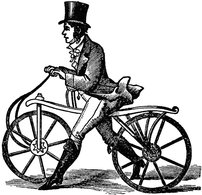"When I see an adult on a bicycle, I do not despair for the future of the human race."
- H.G. Wells
The history of the bike saddle, or bike seat, goes hand-in-hand with the history of the bicycle. Thankfully even the first bicycles had a seat for the rider, otherwise it would have been an incredibly uncomfortable ride and bicycles may have never caught on!
|
The first “bicycle” was invented by Baron Karl von Drais who patented the Laufmaschine (laugh machine?) in Germany in 1818. Also known as the draisine, it was a two-wheeled contraption that you straddled and pushed yourself along using your feet – pedals weren’t invented for another 40 years or so. The seat on the Laufmaschine … a wooden plank. |
|
In England in 1870, the “penny-farthing” was introduced by James Starley, what everyone typically thinks of as the first bicycle, with a huge front wheel that the rider sits over, and a tiny little rear wheel. The large front wheel of the high-wheeler provided one major benefit: speed. In fact, the sport of bicycle racing was born on these dangerous high-wheelers. And though the seats were slightly more sophisticated than a wooden board to sit on, they were also incredibly uncomfortable, made of steel with little or no padding for the rider. |
Then in 1887, John Kemp Starley, none other than James Starley’s nephew, invented the “safety bicycle” and cycling exploded. The safety bicycle used a chain drive where the size the cogs determined the speed of the bicycle, thus eliminating the need for the large front wheel of the penny-farthing. Add the invention of pneumatic tires a couple years later by Dunlop, and essentially the modern bicycle was born.
It’s important to realize that bicycles were invented in a time when cars were virtually non-existent (Carl Benz sold around twenty five cars between 1880 and 1893). Either you had a horse or you walked, those were the options. But the bicycle changed all of that. Though you couldn’t carry a passenger with you on your bike yet, bicycles were affordable, making longer-distance travel accessible even in growing cities where there wasn’t enough room for horses and a stable. And most importantly, bicycles were a whole lot of fun to ride. Cycling became a lifestyle. If you went to Madison Square Garden in New York City in the 1890s, you weren’t there for a basketball game, you were there to watch the bike races! And it was just as much a spectator sport then as a basketball game is today.
|
“It is by riding a bicycle that you learn the contours of a country best, since you have to sweat up the hills and coast down them. Thus you remember them as they actually are, while in a motor car only a high hill impresses you, and you have no such accurate remembrance of country you have driven through as you gain by riding a bicycle.” - Ernest Hemingway |
Improvements to the bicycle seat since the days of the original “safety bicycle” have been minimal. The primary focus has been to give the riders’ legs the freedom of motion for pedaling – comfort has always been an afterthought. Technology and new materials have helped the plight of the bicyclist’s rear end, but it’s only recently that more energy has been focused on creating seats that are more comfortable than the conventional bike seat. And even now, many cyclists avoid these specialty seats, preferring a well-padded, conventional saddle that minimizes additional weight, as speed is often the primary goal of today’s bicyclists.
Carrying a passenger on a bicycle is also still relatively uncharted territory ... hopefully not for long!
Carrying a passenger on a bicycle is also still relatively uncharted territory ... hopefully not for long!





